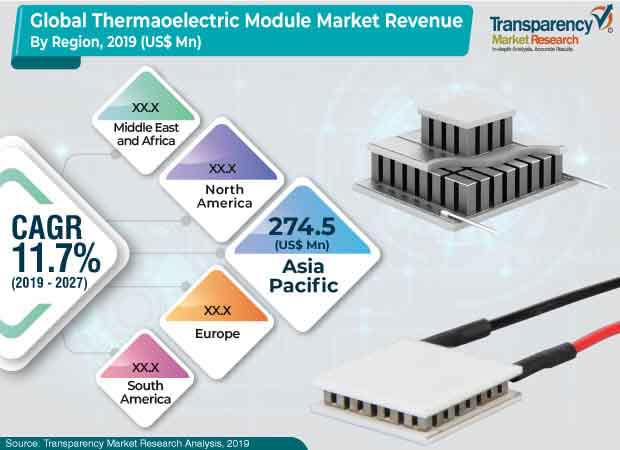
According to a new market research report titled ‘Thermoelectric Module Market – Global Industry Analysis, Size, Share, Growth, Trends and Forecast, 2019–2027,’ published by Transparency Market Research, the global thermoelectric module market is expected to reach value of US$ 1,713.9 Mn by 2027, expanding at a CAGR of 11.7% from 2019 to 2027. According to the report, the global market is expected to be influenced by a range of macroeconomic factors, such as GDP and market trends, during the forecast period. In terms of demand, Asia Pacific is projected to lead the global market in the next few years. The market in the region is likely to expand at a CAGR of 12.1% during the forecast period.

Advantages offered by thermoelectric modules over conventional products to drive the global thermoelectric module market
The global thermoelectric module market is projected to expand at a significant growth rate during the forecast period, owing to advantages offered by thermoelectric modules over conventional products across the world. Large thermoelectric systems have been built for special applications such as railroad cars, cooling within submarines, and semiconductor manufacturing. Presently, thermoelectric systems with high power are being preferred in the market. Thermoelectric systems with their capacity ranging from 200 Watt to 400 Watt are being commonly used in various sectors such as automotive and industrial.
Global Thermoelectric Module Market: Scope of Report
The global thermoelectric module market has been broadly segmented based on technology, material, type, application, end-use industry, and region. In terms of technology, the market has been segmented into single stage and multi stage. Among these, the single stage segment holds a significant share of the market and it is anticipated to expand at a CAGR of 11.4% during the forecast period. Based on material, the market has been classified into bismuth telluride (Bi2Te3), lead telluride (PbTe), silicon germanium (SiGe), and others. Among these, the bismuth telluride segment held a prominent i.e. 39.9% share of the global thermoelectric module market in 2018. It was followed by the lead telluride segment. In terms of type, the global thermoelectric module market has been divided into bulk (standard) TEM, micro TEM, and thin-film TEM. Among these, the bulk (standard) TEM segment held a significant share of the global market in 2018.
Request a Sample – https://www.transparencymarketresearch.com/sample/sample.php?flag=S&rep_id=5444
It is expected to expand at a CAGR of 11.5% during the forecast period. In terms of application, the market has been categorized into analytical instrumentation, automotive electronics & safety systems, refrigeration & cryogenics, thermal cycling, detectors, and others. The refrigeration & cryogenics segment held a major share of the global market in 2018. It is anticipated to expand at a CAGR of 11.2% during the forecast period. Based on end-use industry, the market has been segmented into aerospace & defense, automotive, consumer electronics, healthcare, food & beverages, energy & utility, and others. Among these, the consumer electronics segment held a significant i.e. 33.5% share of the global market in 2018. In terms of region, the global thermoelectric module market has been segregated into North America, Europe, Asia Pacific, Middle East & Africa, and South America.
In terms of revenue, Asia Pacific held a leading share of the global thermoelectric module market in 2018. The market in the region is anticipated to expand at a CAGR of 12.1% during the forecast period. Use of advanced thermoelectric materials for the manufacture of thermoelectric modules has led to rise in the adoption of thermoelectric modules in the region. In terms of revenue, China holds a major share of the thermoelectric module market in Asia Pacific, followed by Japan. Moreover, in terms of revenue, the market in India is anticipated to expand at a significant CAGR of 12.7% between 2019 and 2027.





